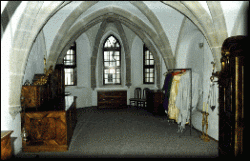The first abolishment of the Monastery Vyšší Brod / Hohenfurth
 While the monastery got away mildly during the land reform in the first Czechoslovak Republic, not least all due to the negotiating skill of Abbot Tecelin Jaksch, the first disaster, the first abolishment of the monastery in its history, came after the occupation of the Sudetenland by Germany. This territory, the German part of South Bohemia, was gradually attached, in political terms, to what the Third Reich called the district of Upper Danube. The church administration attached the area to the diocese Linz and made it into the General Vicariate Vyšší Brod /Hohenfurth. The General Vicar was Father Dr. Dominik Kaindl, a former professor at the diocesan seminary in České Budějovice, who died at the Heiligenkreuz Monastery near Vienna in 1973.
While the monastery got away mildly during the land reform in the first Czechoslovak Republic, not least all due to the negotiating skill of Abbot Tecelin Jaksch, the first disaster, the first abolishment of the monastery in its history, came after the occupation of the Sudetenland by Germany. This territory, the German part of South Bohemia, was gradually attached, in political terms, to what the Third Reich called the district of Upper Danube. The church administration attached the area to the diocese Linz and made it into the General Vicariate Vyšší Brod /Hohenfurth. The General Vicar was Father Dr. Dominik Kaindl, a former professor at the diocesan seminary in České Budějovice, who died at the Heiligenkreuz Monastery near Vienna in 1973.
In early October 1938 the German invasion of the southern Bohemian Forest began. As early as the 21st November 1938 Abbot Tecelin Jaksch was, owing to his loyal attitude to the Czechoslovak Republic, arrested and brought to prison in Linz, later in Český Krumlov. He was sentenced to imprisonment for half a year. He spent the war in the then Protectorate Bohemia and Moravia, in the women’s Cistercian Monastery Tišnov. During his absence, Father Dr. Dominik Kaindl, who was General Vicar at the same time of the German part of the Diocese of České Budějovice, was elected Abbot Coadjutor and confirmed by Rome. As early as January 1939 the administration of the monastery was taken over by a government commissar appointed by the district Upper Danube, and thus the Abbot Coadjutor and the monastic community had no influence on economic life of the Monastery Vyšší Brod. In the course of the abolishment of monasteries in the district Upper Danube, the Monastery Vyšší Brod was abolished by the Gestapo on the 17th April 1941. This was carried out in a manner typical of totalitarian regimes, including body checks, cross-examinations etc. The few, mostly elderly, priests remaining in the monastery were allocated to particular monastery parishes. The only brothers allowed to stay in the monastery during the war were Father Vinzenz Pils as rent administrator to carry out the ongoing administration and accountancy, and Father Alois Martetschläger to continue services in the monastery church and later, when it was closed down, in the small St. Joseph’s Church, situated half-way between the monastery and the town. The empty main building first served as accommodation for German re-settlers from Bessarabia, and towards the end of the war as a reserve military hospital of the German army - Wehrmacht.
As early as January 1939 the administration of the monastery was taken over by a government commissar appointed by the district Upper Danube, and thus the Abbot Coadjutor and the monastic community had no influence on economic life of the Monastery Vyšší Brod. In the course of the abolishment of monasteries in the district Upper Danube, the Monastery Vyšší Brod was abolished by the Gestapo on the 17th April 1941. This was carried out in a manner typical of totalitarian regimes, including body checks, cross-examinations etc. The few, mostly elderly, priests remaining in the monastery were allocated to particular monastery parishes. The only brothers allowed to stay in the monastery during the war were Father Vinzenz Pils as rent administrator to carry out the ongoing administration and accountancy, and Father Alois Martetschläger to continue services in the monastery church and later, when it was closed down, in the small St. Joseph’s Church, situated half-way between the monastery and the town. The empty main building first served as accommodation for German re-settlers from Bessarabia, and towards the end of the war as a reserve military hospital of the German army - Wehrmacht.
